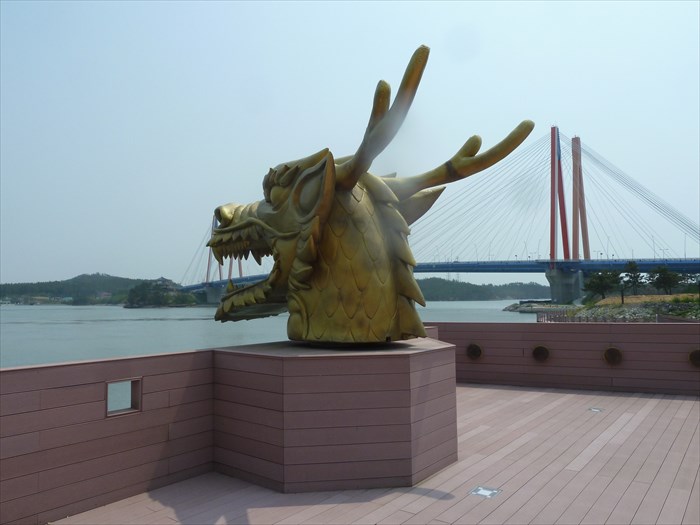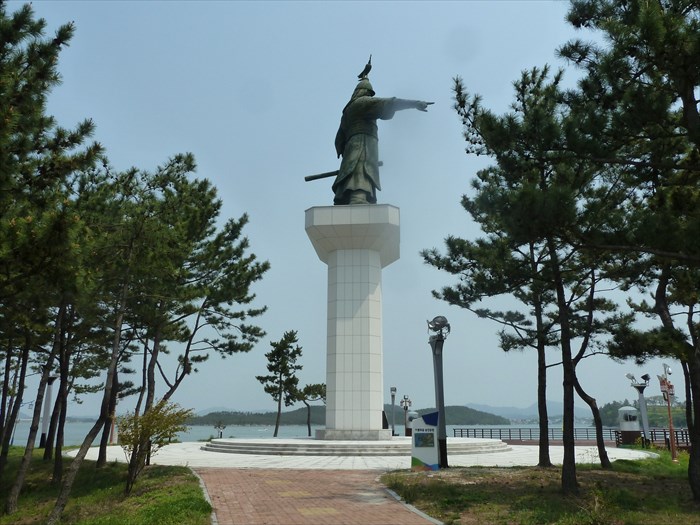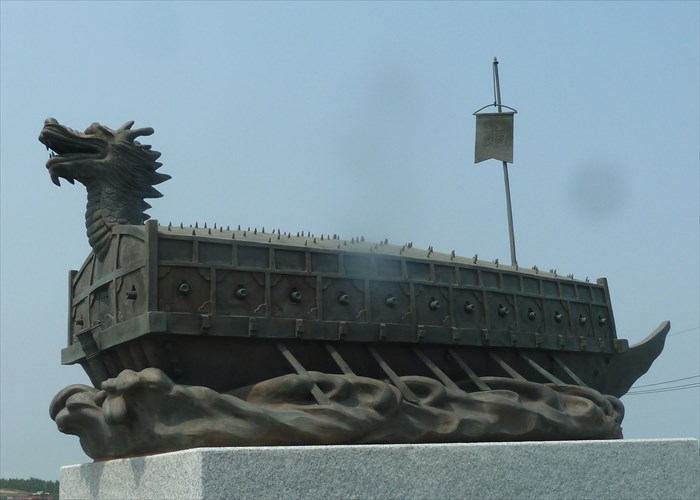
This dragon head has become iconic in Korean history as the figure head of Admiral Yi's famed turtle ships, the first iron-clad vessels to be used in naval warfare. Replicas of it are abundant, but this is the largest that I have seen, perhaps 12 ft x 6 ft. It appears to be made of fiberglass, painted bright gold, and is mounted on an observation deck in the Admiral Yi Victory Park along the boardwalk there. It roughly resembles the end of a ship. This boardwalk extends along the edge of the waters of Myeongyang Straight from the park's southern edge out to the statue of Admiral Lee, offering views of the sea and the Great Jindo Bridges.

The dominating feature of this park is the great bronze statue of Admiral Yi Sun-shin. Although I could find no statistics on this colossal stature, I would estimate its height to be at least twenty feet, and the tall pedestal another thirty feet. Let's just say that this is an imposing statue visible from quite a distance, and overwhelming when one stands near it. Admiral Yi is depicted in full battle armor with his right arm outstretched as if instructing his ships, with his left hand gripping his sword at his side.
There is also a bronze relief sculpture of the a battle and interpretive signs. This boardwalk runs along the the shore from the statue to an elevated viewing deck with a replica of the dragon head that was mounted on some of the famous iron-clad turtle ships that were a major factor in Admiral Yi's navel victories.
This is a new park still being developed on the island of Jindo just northwest of the great pair of suspension bridges that connect it to the mainland. This figure of Admiral Yi is facing the Myeongnyang Straight and the bridge. At the time of this visit in the spring of 2012, there was a new visitors center, perhaps museum, under construction for a new section of the park.
The Great Jindo Bridge itself was a historic construction in 1984 as the longest suspension bridge in Korea at the time. A second bridge, on which this statue stands, was built in 2005 beside the original, narrow bridge. There are smaller statues of Admiral Yi at each end of the second bridge, with statues of his famous turtle boats (the world's first iron-clad naval vessels) across from them.

This model of Admiral Yi's armored turtle appears at each end of the Great Jindo Bridge 2. The dragon head is mounted at one end. The addition of metal spikes to the iron-clad covering made it almost impossible for invaders to penetrate the armor.
Admiral Yi (also spelled Lee, pronounced in Korean simply as "ee") is undoubtedly the most celebrated hero in Korean history. Statues of him are everywhere, including the monumental statue in Gwangwhamun, Seoul. But, he is especially honored here on the southern coast of Korea where his final battles with the Japanese invaders took place.
Yi Sun-shin was a brilliant military strategist. Although he had no prior naval training or experience, his dominance during the Japanese invasion of the Korean peninsula in the 16th century is legendary. Indeed, his defeat of the Japanese in battle after battle, was the crucial element in their defeat after they had nearly consolidated their occupation, with designs to move on into China.
The Myeongnyang Straight, between Jindo and the mainland, is where Admiral Yi fought one of the most decisive and celebrated battles of the war, crushing an armada of 113 Japanese warships and its 200 support vessels with only 13 of his own ships. It was partly his knowledge of the treacherous tides here, rated as the fastest tidal currents in Asia, with its unpredictable eddies and reversals, that led to Yi's great victory on October 26, 1597